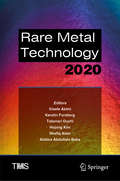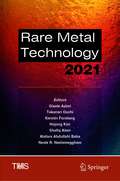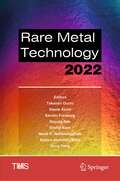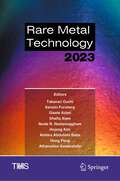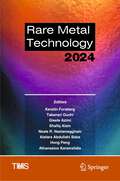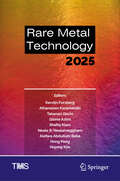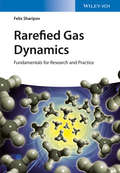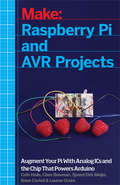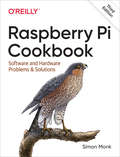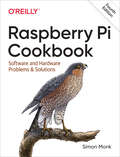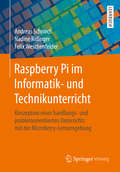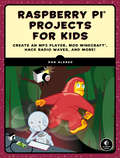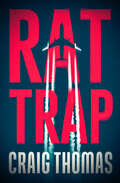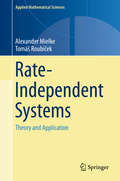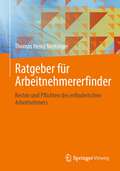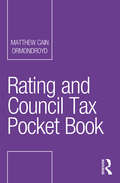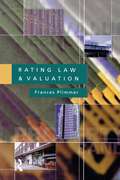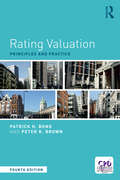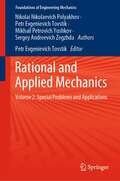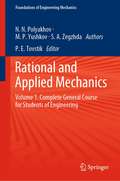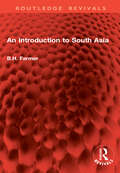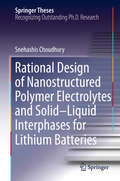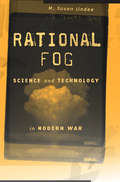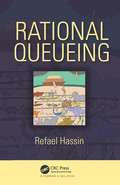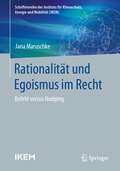- Table View
- List View
Rare Metal Technology 2020 (The Minerals, Metals & Materials Series)
by Hojong Kim Shafiq Alam Takanari Ouchi Gisele Azimi Alafara Abdullahi Baba Kerstin ForsbergThis collection presents papers from a symposium on extraction of rare metals as well as rare extraction processing techniques used in metal production. Rare metals include strategic metals that are in increasing demand and subject to supply risks. Metals represented include neodymium, dysprosium, scandium and others; platinum group metals including platinum, palladium, iridium, and others; battery related metals including lithium, cobalt, nickel, and aluminum; electronics-related materials including copper and gold; and refectory metals including titanium, niobium, zirconium, and hafnium. Other critical materials such as gallium, germanium, indium and silicon are also included. Papers cover various processing techniques, including but not limited to hydrometallurgy (solvent extraction, ion exchange, precipitation, and crystallization), electrometallurgy (electrorefining and electrowinning), pyrometallurgy, and aeriometallurgy (supercritical fluid extraction). Contributions are focused on primary production as well as secondary production through urban mining and recycling to enable a circular economy.A useful resource for all involved in commodity metal production, irrespective of the major metalProvides knowledge of cross-application among industriesExtraction and processing of rare metals that are the main building block of many emerging critical technologies have been receiving significant attention in recent years.The technologies that rely on critical metals are prominent worldwide, and finding a way to extract and supply them effectively is highly desirable and beneficial.
Rare Metal Technology 2021 (The Minerals, Metals & Materials Series)
by Gisele Azimi Takanari Ouchi Kerstin Forsberg Hojong Kim Shafiq Alam Alafara Abdullahi Baba Neale R. NeelamegghamThis collection presents papers from a symposium on extraction of rare metals as well as rare extraction processing techniques used in metal production. It covers metals essential for critical modern technologies including electronics, electric motors, generators, energy storage systems, and specialty alloys. Rare metals are the main building blocks of many emerging critical technologies and have been receiving significant attention in recent years. Much research in academia and industry is devoted to finding novel techniques to extract critical and rare metals from primary and secondary sources. The technologies that rely on critical metals are dominating the world, and finding a way to extract and supply them effectively is highly desirable and beneficial. Rapid development of these technologies entails fast advancement of the resource and processing industry for their building materials. Authors from academia and industry exchange knowledge on developing, operating, and advancing extractive and processing technologies. Contributions cover rare-earth elements (magnets, catalysts, phosphors, and others), energy storage materials (lithium, cobalt, vanadium, graphite), alloy elements (scandium, niobium, titanium), and materials for electronics (gallium, germanium, indium, gold, silver). The contributions also cover various processing techniques in mineral beneficiation, hydrometallurgy, separation and purification, pyrometallurgy, electrometallurgy, supercritical fluid extraction, and recycling (batteries, magnets, electrical and electronic equipment).
Rare Metal Technology 2022 (The Minerals, Metals & Materials Series)
by Neale R. Neelameggham Hojong Kim Shafiq Alam Takanari Ouchi Gisele Azimi Alafara Abdullahi Baba Kerstin Forsberg Hong PengThis collection presents papers from a symposium on extraction of rare metals from primary and secondary materials and residues as well as rare extraction processing techniques used in metal production. Authors cover the extraction of less common or minor metals including elements such as antimony, bismuth, barium, beryllium, boron, calcium, chromium, gallium, germanium, hafnium, indium, manganese, molybdenum, platinum group metals, rare earth metals, rhenium, scandium, selenium, sodium, strontium, tantalum, tellurium, and tungsten. Contributions also discuss rare metals of low-tonnage sales compared to high-tonnage metals (iron, copper, nickel, lead, tin, zinc, or light metals such as aluminum, magnesium, or titanium and electronic metalloid silicon). Authors also cover biometallurgy, hydrometallurgy, and electrometallurgy while novel high-temperature processes such as microwave heating, solar-thermal reaction synthesis, and cold crucible synthesis of rare metals are addressed. Also included in this collection is the design of extraction equipment used in these processes from suppliers as well as laboratory and pilot plant studies.
Rare Metal Technology 2023 (The Minerals, Metals & Materials Series)
by Takanari Ouchi Kerstin Forsberg Gisele Azimi Shafiq Alam Neale R. Neelameggham Hojong Kim Alafara Abdullahi Baba Hong Peng Athanasios KaramalidisThis collection presents papers from a symposium on extraction of rare metals from primary and secondary materials and residues as well as rare metals extraction processing techniques used in metal production. The collection covers the extraction of less common or minor metals including elements such as antimony, bismuth, barium, beryllium, boron, calcium, chromium, gallium, germanium, hafnium, indium, manganese, molybdenum, platinum group metals, rare earth metals, rhenium, scandium, selenium, sodium, strontium, tantalum, tellurium, and tungsten. It also includes rare metals of low-tonnage sales compared to high-tonnage metals (iron, copper, nickel, lead, tin, zinc, or light metals such as aluminum, magnesium, or titanium and electronic metalloid silicon). Rare metal processing covers bio-metallurgy, hydro-metallurgy, and electro-metallurgy while novel high-temperature processes such as microwave heating, solar-thermal reaction synthesis, and cold crucible synthesis of rare metals are also addressed. Also included in this collection is the design of extraction equipment used in these processes from suppliers as well as laboratory and pilot plant studies.
Rare Metal Technology 2024 (The Minerals, Metals & Materials Series)
by Kerstin Forsberg Takanari Ouchi Gisele Azimi Shafiq Alam Neale R. Neelameggham Alafara Abdullahi Baba Hong Peng Athanasios KaramalidisThis collection presents papers from a symposium on extraction of rare metals from primary and secondary materials and residues as well as rare extraction processing techniques used in metal production. The collection covers the extraction of less common or minor metals including elements such as antimony, bismuth, barium, beryllium, boron, calcium, chromium, gallium, germanium, hafnium, indium, manganese, molybdenum, platinum group metals, rare earth metals, rhenium, scandium, selenium, sodium, strontium, tantalum, tellurium, and tungsten. It also includes rare metals of low-tonnage sales compared to high-tonnage metals (iron, copper, nickel, lead, tin, zinc, or light metals such as aluminum, magnesium, or titanium and electronic metalloid silicon). Rare metal processing covers bio-metallurgy, hydro-metallurgy, and electro-metallurgy while novel high-temperature processes such as microwave heating, solar-thermal reaction synthesis, and cold crucible synthesis of rare metals are also addressed. Also included in this collection is the design of extraction equipment used in these processes from suppliers as well as laboratory and pilot plant studies.
Rare Metal Technology 2025 (The Minerals, Metals & Materials Series)
by Kerstin Forsberg Athanasios Karamalidis Takanari Ouchi Gisele Azimi Shafiq Alam Neale R. Neelameggham Alafara Abdullahi Baba Hong Peng Hojong KimThis volume presents papers from a symposium on extraction of rare metals from primary and secondary materials and residues as well as rare extraction processing techniques used in metal production. The collection covers the extraction of less common or minor metals including elements such as antimony, bismuth, barium, beryllium, boron, calcium, chromium, gallium, germanium, hafnium, indium, manganese, molybdenum, platinum group metals, rare earth metals, rhenium, scandium, selenium, sodium, strontium, tantalum, tellurium, and tungsten. It also includes rare metals of low-tonnage sales compared to high-tonnage metals (iron, copper, nickel, lead, tin, zinc, or light metals such as aluminum, magnesium, or titanium and electronic metalloid silicon). Rare metal processing covers biometallurgy, hydrometallurgy, and electrometallurgy while novel high-temperature processes such as microwave heating, solar-thermal reaction synthesis, and cold crucible synthesis of rare metals are also addressed. Also included in this collection is the design of extraction equipment used in these processes from suppliers as well as laboratory and pilot plant studies.
Rarefied Gas Dynamics
by Felix SharipovAimed at both researchers and professionals who deal with this topic in their routine work, this introduction provides a coherent and rigorous access to the field including relevant methods for practical applications. No preceding knowledge of gas dynamics is assumed.
Raspberry Pi and AVR Projects: Augmenting the Pi's ARM with the Atmel ATmega, ICs, and Sensors
by Cefn Hoile Clare Bowman Sjoerd Dirk Meijer Brian Corteil Lauren Orsini Troy MottAs an incredibly cheap, credit-card sized computer, the Raspberry Pi is breaking down barriers by encouraging people of all ages to experiment with code and build new systems and objects; and this book provides readers with inspiring and insightful examples to explore and build upon. Written for intermediate to seasoned Raspberry Pi users, this book explores four projects from around the world, explained by their makers. These projects cover five major categories in the digital maker space: music, light, games, home automation, and the Internet of Things.
Raspberry Pi Cookbook: Software and Hardware Problems and Solutions
by Simon MonkWith millions of new users and several new models, the Raspberry Pi ecosystem continues to expand—along with many new questions about the Pi’s capabilities. The third edition of this popular cookbook provides more than 200 hands-on recipes that show you how to run this tiny low-cost computer with Linux; program it with Python; hook it up to sensors, motors, and Arduino boards; and even use it with the internet of things (IoT).Prolific hacker and author Simon Monk also teaches basic principles to help you use new technologies with the Raspberry Pi. This cookbook is ideal for programmers and hobbyists familiar with the Pi through resources such as Getting Started with Raspberry Pi (O’Reilly). Code examples from the book are available on GitHub.Set up your Raspberry Pi and connect to a networkWork with its Linux-based operating systemProgram your Raspberry Pi with PythonGive your Pi "eyes" with computer visionControl hardware through the GPIO connectorUse your Raspberry Pi to run different types of motorsWork with switches, keypads, and other digital inputsUse sensors to measure temperature, light, and distanceConnect to IoT devices in various ways and automate your home
Raspberry Pi Cookbook: Software and Hardware Problems and Solutions
by Simon MonkIf you've started to work with Raspberry Pi, you know that Raspberry Pi's capabilities are continually expanding. The fourth edition of this popular cookbook provides more than 200 hands-on recipes (complete with code) that show you how to run this tiny low-cost computer with Linux, program it with Python, hook it up to sensors and motors, and use it with the internet of things (IoT). This new edition includes new chapters on the Raspberry Pi Pico and machine learning with the Raspberry Pi.These easy-to-use recipes will show you, step-by-step, how to:Set up your Raspberry Pi and connect to a networkWork with its Linux-based operating systemProgram your Raspberry Pi with PythonGive your Pi "eyes" with computer visionRecognize objects from video and sounds using machine learningControl hardware through the GPIO connectorUse your Raspberry Pi to run different types of motorsWork with switches, keypads, and other digital inputsUse sensors to measure temperature, light, and distanceConnect to IoT devices in various ways and automate your homeUse the Raspberry Pi Pico microcontroller board with your Raspberry Pi
Raspberry Pi im Informatik- und Technikunterricht: Konzeption eines handlungs- und problemorientierten Unterrichts mit der MicroBerry-Lernumgebung
by Andreas Schnirch Nadine Ridinger Felix WeschenfelderDieses Buch beschreibt erprobte und evaluierte Unterrichtssequenzen zum Experimentieren mit dem Raspberry Pi im Informatik- und Technikunterricht der Sekundarstufe. Ausgehend von den Zielen eines modernen Informatikunterrichts wird gezeigt, wie eine interessen- und motivationsfördernde Raspberry-Pi Lernumgebung aussehen kann. Neben konkreten und differenzierten Unterrichtseinheiten, mit denen sich Schülerinnen und Schüler experimentell die Grundbausteine von Algorithmen erschließen können, werden Unterrichtseinheiten für fortgeschrittene Lernende sowie Projekte vorgestellt. Die vorgestellten Konzepte unterstützen Lehrerinnen und Lehrer wirkungsvoll bei der Konzeption des eigenen Unterrichts, können aber auch als Selbstlernmodule genutzt werden.
Raspberry Pi Projects for Kids: Create an MP3 Player, Mod Minecraft, Hack Radio Waves, and More!
by Dan AldredLearn coding and electronics through 12 original and daring projects that hack wireless signals.The Raspberry Pi is an inexpensive, pocket-sized computer that will help you build and code your own hardware projects.Raspberry Pi Projects for Kids will show you how to harness the power of the Raspberry Pi to create 12 cool projects using simple code and common materials like a webcam, microphone, and LED lights. Step-by-step instructions and detailed diagrams guide you through each project.After a brief introduction to the Python programming language, you'll learn how to: • Create an LED night-light that turns itself on and off • Set up a Raspberry Pi camera to take selfies and videos • Set up a webcam to stream video to your cell phone • Manipulate environments in Minecraft • Hijack local radio waves to play your own songs and recordings • Configure Raspberry Pi to send texts to a cell phone • Track your family members' locations via wi-fi and Bluetooth • Create an MP3 player • Set up a camera to take motion-triggered photos of wildlife • Control the electronics in your home with your cell phone • Teach Raspberry Pi to read aloud posts from your Twitter feed • Play "Rock, Paper, Scissors" against Raspberry PiRaspberry Pi Projects for Kids will deliver hours of fun and endless inspiration!
Rat Trap
by Craig ThomasNew York Times–Bestselling Author: A hijacking at a London airport leads to a manhunt for an arms dealer as the clock ticks down to disaster . . . Engine troubles start just as the jet is approaching Heathrow. Then, after a harrowing landing, just as everyone breathes a sigh of relief, the hijackers rise up . . . Their demand: the release of arms smuggler Shafiq Nasoud from a British prison. Authorities decide to transport him to London in case the situation turns desperate—but things go very wrong. Nasoud escapes. Negotiations continue to fail. The hijackers&’ leader, an American, appears to be strung out on drugs—and the FBI gets in touch to share some deeply concerning information about another terrorist. Before it all ends, blood will be spilled—but whose? Praise for Craig Thomas&’s novels &“Will have you sweating bullets . . . Tension is sustained from first page to last.&” —The New York Times Book Review &“Lively, straightforward action.&” —Kirkus Reviews (starred review) &“The last word in espionage thrillers.&” —The Pittsburgh Press
Rate-Independent Systems
by Alexander Mielke Tomáš RoubíčekThis monograph provides both an introduction to and a thorough exposition of the theory of rate-independent systems, which the authors have been working on with a lot of collaborators over 15 years. The focus is mostly on fully rate-independent systems, first on an abstract level either with or even without a linear structure, discussing various concepts of solutions with full mathematical rigor. Then, usefulness of the abstract concepts is demonstrated on the level of various applications primarily in continuum mechanics of solids, including suitable approximation strategies with guaranteed numerical stability and convergence. Particular applications concern inelastic processes such as plasticity, damage, phase transformations, or adhesive-type contacts both at small strains and at finite strains. A few other physical systems, e. g. magnetic or ferroelectric materials, and couplings to rate-dependent thermodynamic models are considered as well. Selected applications are accompanied by numerical simulations illustrating both the models and the efficiency of computational algorithms. In this book, the mathematical framework for a rigorous mathematical treatment of "rate-independent systems" is presented in a comprehensive form for the first time. Researchers and graduate students in applied mathematics, engineering, and computational physics will find this timely and well written book useful.
Ratgeber für Arbeitnehmererfinder: Rechte und Pflichten des erfinderischen Arbeitnehmers
by Thomas Heinz MeitingerUngefähr 80% der Erfindungen in Deutschland stammen von Arbeitnehmern. Für diese Gruppe von Erfindern ist das Gesetz über Arbeitnehmererfindungen einschlägig. Das Gesetz klärt die Kollision des Patentgesetzes mit dem Arbeitsrecht. Das Patentgesetz bestimmt, dass der Erfinder der alleinige Eigentümer seiner Erfindung ist. Im Gegensatz dazu ordnet das Arbeitsrecht ein Arbeitsergebnis, also auch eine Erfindung eines Arbeitnehmers, dem Eigentum des Arbeitgebers zu. Der erfinderische Arbeitnehmer, der zumeist eine technische Tätigkeit ausübt, sieht sich unvermittelt mit rechtlichen Fragestellungen konfrontiert. Sein Gegenüber ist ein Patentanwalt, der ein Angestellter seines Unternehmens ist oder der von seinem Unternehmen beauftragt wurde. Der „Gegenspieler“ des erfinderischen Arbeitnehmers ist daher juristisch versiert. Waffengleichheit im Gespräch des erfinderischen Arbeitnehmers mit den Vertretern des Arbeitgebers besteht nicht. Dieses Fachbuch gibt dem Arbeitnehmer das rechtliche Know-How, um seine Interessen erfolgreich zu verfolgen. Der Arbeitgeber wird es in aller Regel begrüßen, dass sein Arbeitnehmer Sachkompetenz erwirbt. Hierdurch wird zumeist eine schnelle Einigung der Parteien ermöglicht und dadurch der Arbeitsfrieden bewahrt.
Rating and Council Tax Pocket Book (Routledge Pocket Books)
by Matthew Cain OrmondroydThe Rating and Council Tax Pocket Book is a concise, practical guide to the legal and practical issues surrounding non-domestic rates and council tax. An essential tool for busy tax collection practitioners in local authorities and private practice, it will also be suitable for a range of non-specialist property professionals who may have to deal with rates and council tax matters as part of their practice. This handy pocket guide is accessible to specialist and non-specialist alike, covering everything from key concepts through to liability, exemptions, procedure and completion notices. The book encompasses both English and Welsh law, and includes all the relevant statutory provisions. With detailed discussion of key cases, this is a book that no one with an interest in rating and council tax should be without.
Rating Law and Valuation
by Frances A.S. PlimmerFollowing the introduction of the uniform business rate in 1990, local property taxation changed dramatically, whilst retaining many of its historical and familiar characteristics. Rating Law and Valuation details the existing, non-domestic rating system from the principles of rate liability and the definition of hereditament, the rateable value, to the procedure for compiling and altering the rating lists.The book also discusses how the methods of valuation are used by rating valuers to produce rateable values for the more common property types. The text concludes with a similar treatment of Council Tax which is levied on domestic property.Rating Law and Valuation is written primarily for those studying property valuation as part of their course, and is an indispensible reference book for those taking professional courses of The Royal Institution of Chartered Surveyors (RICS), Incorporated Society of Valuers and Auctioneers (ISVA), and Institute of Revenue and Rating Valuation (IRRV). It is also a useful resource for practitioners who are required to deal with rating law and valuation but who do not do so on a regular basis.
Rating Valuation: Principles and Practice
by Patrick H. Bond Peter K. BrownRating Valuation: Principles and Practice has long been the standard go-to guide for both students studying rating valuation and practitioners needing a comprehensive reference book covering rating law, valuation and, importantly, practice. This fourth edition brings the reader up to date with the changes for the 2017 Rating Revaluation, including the new Check, Challenge and Appeal procedures, and developments in case law, as well as highlights the differences between the law in England and Wales. A comprehensive chapter on Northern Ireland rating has been added to this edition. Starting with the basics, the book goes on to provide more in-depth detail for advanced readers, using clear, accessible and engaging analysis and example valuations throughout to break down what many see as a complex subject. Whether you are studying to pass your APC, or just want an overview of the changes taken in by the latest revaluation, Rating Valuation: Principles and Practice will give you all you need to understand rating valuation.
Rational and Applied Mechanics: Volume 2. Special Problems and Applications (Foundations of Engineering Mechanics)
by Nikolai Nikolaevich Polyakhov Petr Evgenievich Tovstik Mikhail Petrovich Yushkov Sergey Andreevich ZegzhdaAvailable for the first time in English, this two-volume course on theoretical and applied mechanics has been honed over decades by leading scientists and teachers, and is a primary teaching resource for engineering and maths students at St. Petersburg University.The course addresses classical branches of theoretical mechanics (Vol. 1), along with a wide range of advanced topics, special problems and applications (Vol. 2). Among the special applications addressed in this second volume are: stability of motion, nonlinear oscillations, dynamics and statics of the Stewart platform, mechanics under random forces, elements of control theory, relations between nonholonomic mechanics and the control theory, vibration and autobalancing of rotor systems, physical theory of impact, statics and dynamics of a thin rod.This textbook is aimed at students in mathematics and mechanics and at post-graduates and researchers in analytical mechanics.
Rational and Applied Mechanics: Volume 1. Complete General Course for Students of Engineering (Foundations of Engineering Mechanics)
by Nikolai Nikolaevich Polyakhov Mikhail Petrovich Yushkov Sergey Andreevich ZegzhdaAvailable for the first time in English, this two-volume course on theoretical and applied mechanics has been honed over decades by leading scientists and teachers, and is a primary teaching resource for engineering and maths students at St. Petersburg University.The course addresses classical branches of theoretical mechanics (Vol. 1), along with a wide range of advanced topics, special problems and applications (Vol. 2). This first volume of the textbook contains the parts “Kinematics” and “Dynamics”. The part “Kinematics” presents in detail the theory of curvilinear coordinates which is actively used in the part “Dynamics”, in particular, in the theory of constrained motion and variational principles in mechanics. For describing the motion of a system of particles, the notion of a Hertz representative point is used, and the notion of a tangent space is applied to investigate the motion of arbitrary mechanical systems. In the final chapters Hamilton-Jacobi theory is applied for the integration of equations of motion, and the elements of special relativity theory are presented.This textbook is aimed at students in mathematics and mechanics and at post-graduates and researchers in analytical mechanics.
Rational Approaches to Structure, Activity, and Ecotoxicology of Agrochemicals
by Wilfried Draber Toshio FujitaThis book presents discussions of the most important aspects in the development of agrochemicals. The book covers such broad areas as structure activity and ecotoxicological analyses in comprehensive reviews for general methods and chronicles for individual examples. Topics in structure-activity relationships include how to combine submolecular structures of pharmacological interests and modify them according to chemorational models with computer-aided procedures such as the traditional Hansch-type QSAR, the sequential, simplex optimization, and molecular modeling. Topics in the ecotoxicology of organo phosphorus compounds are discussed in terms of the quantitative structure-toxicity relationship (QSTR). Chronicles of molecular orbital methodology in predicting environmental fates of agrochemicals are also provided. This volume will be invaluable for researchers in the agrochemical and pharmaceutical industries.
Rational Design of Nanostructured Polymer Electrolytes and Solid–Liquid Interphases for Lithium Batteries (Springer Theses)
by Snehashis ChoudhuryThis thesis makes significant advances in the design of electrolytes and interfaces in electrochemical cells that utilize reactive metals as anodes. Such cells are of contemporary interest because they offer substantially higher charge storage capacity than state-of-the-art lithium-ion battery technology. Batteries based on metallic anodes are currently considered impractical and unsafe because recharge of the anode causes physical and chemical instabilities that produce dendritic deposition of the metal leading to catastrophic failure via thermal runaway. This thesis utilizes a combination of chemical synthesis, physical & electrochemical analysis, and materials theory to investigate structure, ion transport properties, and electrochemical behaviors of hybrid electrolytes and interfacial phases designed to prevent such instabilities. In particular, it demonstrates that relatively low-modulus electrolytes composed of cross-linked networks of polymer-grafted nanoparticles stabilize electrodeposition of reactive metals by multiple processes, including screening electrode electrolyte interactions at electrochemical interfaces and by regulating ion transport in tortuous nanopores. This discovery is significant because it overturns a longstanding perception in the field of nanoparticle-polymer hybrid electrolytes that only solid electrolytes with mechanical modulus higher than that of the metal electrode are able to stabilize electrodeposition of reactive metals.
Rational Fog: Science And Technology In Modern War
by M. Susan LindeeA thought-provoking examination of the intersections of knowledge and violence, and the quandaries and costs of modern, technoscientific warfare.Science and violence converge in modern warfare. While the finest minds of the twentieth century have improved human life, they have also produced human injury. They engineered radar, developed electronic computers, and helped mass produce penicillin all in the context of military mobilization. Scientists also developed chemical weapons, atomic bombs, and psychological warfare strategies.Rational Fog explores the quandary of scientific and technological productivity in an era of perpetual war. Science is, at its foundation, an international endeavor oriented toward advancing human welfare. At the same time, it has been nationalistic and militaristic in times of crisis and conflict. As our weapons have become more powerful, scientists have struggled to reconcile these tensions, engaging in heated debates over the problems inherent in exploiting science for military purposes. M. Susan Lindee examines this interplay between science and state violence and takes stock of researchers’ efforts to respond. Many scientists who wanted to distance their work from killing have found it difficult and have succumbed to the exigencies of war. Indeed, Lindee notes that scientists who otherwise oppose violence have sometimes been swept up in the spirit of militarism when war breaks out.From the first uses of the gun to the mass production of DDT and the twenty-first-century battlefield of the mind, the science of war has achieved remarkable things at great human cost. Rational Fog reminds us that, for scientists and for us all, moral costs sometimes mount alongside technological and scientific advances.
Rational Queueing (Chapman & Hall/CRC Series in Operations Research)
by Refael HassinUnderstand the Strategic Behavior in Queueing SystemsRational Queueing provides one of the first unified accounts of the dynamic aspects involved in the strategic behavior in queues. It explores the performance of queueing systems where multiple agents, such as customers, servers, and central managers, all act but often in a noncooperative manner.T
Rationalität und Egoismus im Recht: Befehl versus Nudging (Schriftenreihe des Instituts für Klimaschutz, Energie und Mobilität)
by Jana MaruschkeDieses Buch fragt danach, wie Recht und Rechtsprechung, Staats- und Rechtstheorie sowie moderne Verhaltensökonomie die Rationalität und den Egoismus des Menschen begreifen und wie dies die Wahl staatlicher Steuerungsinstrumente beeinflusst. Das scheinbar neuartige Instrument Nudging wird mit Blick auf Umweltschutzinstrumente, die Regulierung des Tabakrauchens und der Organspende in den öffentlich-rechtlichen Handlungsformenkatalog eingeordnet, wobei verfassungsrechtliche Grenzen diskutiert werden. Zielgruppe sind die an der "Metaebene" des Rechts und der Verhaltenssteuerung interessierten Leserinnen und Leser.
